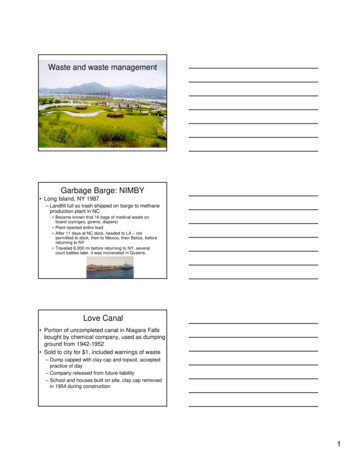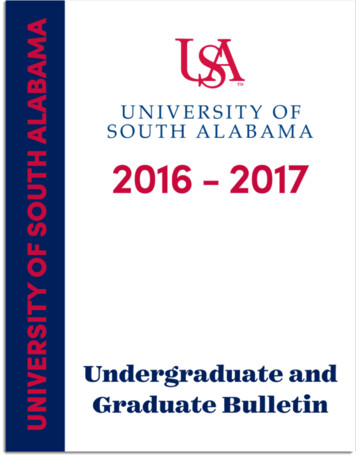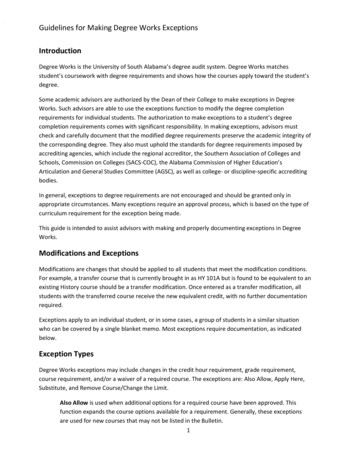
Transcription
Waste and waste managementGarbage Barge: NIMBY Long Island, NY 1987– Landfill full so trash shipped on barge to methaneproduction plant in NC Became known that 16 bags of medical waste onboard (syringes, gowns, diapers) Plant rejected entire load After 11 days at NC dock, headed to LA – notpermitted to dock, then to Mexico, then Belize, beforereturning to NY Traveled 6,000 mi before returning to NY, severalcourt battles later, it was incinerated in Queens.Love Canal Portion of uncompleted canal in Niagara Fallsbought by chemical company, used as dumpingground from 1942-1952 Sold to city for 1, included warnings of waste– Dump capped with clay cap and topsoil, acceptedpractice of day– Company released from future liability– School and houses built on site, clay cap removedin 1954 during construction1
Love Canal Problems began in late1950s – barrels surfaced,children playing near thembecame sick (some died) Fumes killed vegetation,surface pools of toxins 1970s: heavy rain causedblack sludge to leak intobasements; medical studiesshowed higher rates of birthdefects, miscarriages,asthmaLove Canal in 1980 School closed in 1979,houses evacuated Late 1980s – cleanupbegan Limited leakage awayfrom canal site2
Managing garbage Fresh Kills Landfill, NY, Staten Island: largestlandfill in world– Operated for 50 years – NYC only landfill– Closed in March, 2001: Welcomed event for StatenIsland residents– Had 6 mounds of trash (largest higher than Statueof Liberty)– Plans to turn into public park – bigger than CentralParkFresh Kills Stations developed in city to transfer waste outof city on barges and rails– Mob, neighborhood opposition, economic issues,and political shenanigans interfered– Forced to truck out trash to 26 landfills in NY, NJ,VA, PA, OH– Budget doubledMounds1.8 million tons of rubble produced from WorldTrade Center collapse– In 2008, Americans produced 250 tons of trashtotal– Fresh Kills opened to take in rubble– Now closed again – plans on for parks, vistas(from tops of hills of trash), estuary, and trails– Because landfill operated before EPA regulationsin place – will have to be monitored more carefully(not only because of 9/11 rubble) forcontamination3
Waste Any unwanted material or substance Adverse affects of waste:– Degrade water, soil, and air quality Indicates inefficiency in system– Reduce waste potentially reducing cost Why do we study waste management?– Affects air quality, water quality, andenvironmental healthTypes of waste Municipal solid waste (MSW)– Homes, businesses, and institutions Industrial solid waste– Production of consumer goods, mining,agriculture, and petroleum extraction and refining Hazardous waste– Solid or liquid substance that is toxic, chemicallyreactive, flammable, or corrosive Wastewater– Produced from households, businesses,industries, or public facilities4
Waste management Dealing with sites already containing waste– 1989: hazardous waste sites est. at 32,000,could be up to 400,000, not including militarybases Dealing with waste now– Safely storing waste created now and in future Future waste– Reducing the amount of waste generated andpreventing waste from being createdGoals of waste management Minimize the amount of waste generated– Preferable: source reduction: reduce waste atplace generate (house, business, industry) Recover and recycle waste Dispose of waste effectivelyRegulation EPA regulates all waste: household, industrial,manufacturing, hazardous Resource Conservation and Recovery Act (RCRA)– 1976, notable amendments in 1984 to reduce waste– Refinement of earlier law regulating solid waster– Set national goals of: Protecting humans and environment from the potential hazards ofwaste disposal. Energy conservation and natural resources. Reducing the amount of waste generated, through source reductionand recycling Ensuring the management of waste in an environmentally soundmanner.5
Regulations RCRA defines what is hazardous waste Cradle-to-grave approach – used by EPAon hazardous waste– Track all hazardous waste from point ofgeneration to disposal Paper trail Industrial standards for packaging, disposing, andshipping waste– Most notable parts of RCRAWaste stream Waste stream: flowof waste fromsources towarddisposal generationFrom: Essential Environment, Ch 17Municipal solid waste (MSW) Paper largest component (even after recycling) Plastics: greatest increase6
MSW generation by materialThe problem with waste in US 2.9 x mores municipal solid waste is generatedin the US than in 1960 A person generates 72% more waste than in1960 Each person generates approximately 4.5 lbs ofMSW/day– 1642 tons/year or about the weight of a VWBeetle Excess packaging and reliance on nondurablegoods (discarded after short period of use) “The Throwaway society”7
Waste in other countries Developing nations: waste generation rising– Latin America: rates doubled– Middle East: 5x increase Developed nations are more able to manage wasteissues17001600Pounds15001400130012001100lDe ianmarSwki tzerlandCanadaNorwNayetherlandsAuUnstiteridKin agdomIrelandstraAuUS1000OECD Environmental Data Compendium: 2002Waste in other countries Germany leads European nations inrecycling– 70% recycled vs. 33% recycled in US– Waste avoidance is top priority, then recycled,then disposed of in environmental safe way– Polluter pays principle – those who create it dealwith it vs. US – consumer pays Packaging Ordinance: requires all manufacturers tocollect and then recycle or reuse their packaging afterit is disposed of by consumersGerman recycling Trash bins found on street corners, in publicparks and other spaces, in the courtyards ofapartment buildings, and in all single familyhomes– Yellow bin – packaging– Blue bin – paper and cardboard– White bin – white or clear glass– Brown bin – brown glass– Green bin – green glass– “Bio” bin – leftover food and plant waste8
Sanitary Landfills Replaced the “dump”, In US: EPA regulates under the RCRA Policy:– Have 2 to 4 ft of impermeable clay layer– Heavy-duty clay liner– 20 ft above the water table– Series of pipes to collect leachate (liquid thatresults from substances dissolving in landfill)– Wells to vent/collect landfill gasLandfill A landfill “Designed to protect the environment fromcontaminants which may be present in thesolid waste stream”, EPA 2010 Must be located away from wetlands andearthquake-prone faults Waste partially decomposed by bacteria– Compressed under own weight– Soil layered to speed decomposition, reduceodor, and lessen infestation by pests– Need some rainwater to encouragebiodegradation by aerobic and anaerobicbacteria9
Landfills Decomposition in anaerobic environmentproduces landfill gas (approx. ½ is methanegas)– Landfills vented to reduce the buildup of gases– Can be collected and used like natural gas Estimate at Fresh Kills is that it will provide energy for25,000 homesLandfills All landfills eventually close:– 1988: 8,000 landfills– Today: 1,900– Consolidated landfills When closed: landfill “capped” with plastic,gravel, and soil Required leachate to be monitored for 30years after closing Closed landfills make good recreationfacilitiesProblems with landfills NIMBY– Smelly and unsightly– Noisy too – trucks bringing trash– In some 3rd world countries, landfills arescavenged by the poor – items resold In Philippines, a dump was closed in 2000 after anavalanche of trash killed 330 people at site. Old landfills: regulations not in place; mayhave groundwater contamination10
Other ways to get rid of trash Incineration: burned at high temperature– Waste sorted (metals removed) and chopped– Weight reduced by 75%, volume by 90%– Resulting ash is toxic – must be placed inhazardous waste landfills– Airborne particles also toxic Developed nations now regulate emissions Scrubbers treat gases Baghouse: filters to remove particulatesIncinerator diagramEssential Environment, chapter 17Incinerators as power generators In developed nations, waste-to-energy facilities(WTE): burn waste and produce electricity– Produces about 35% of energy generated ifburned coal– Takes a long time to recoup costs11
Data as of 2008– 54% MSW in landfills– 13% incinerators– 33% composting and recyclingWaste hierarchy Waste hierarchy in US– 3R – Reduce, Reuse, Recycle– 4R – Same as above, add Recover Different from European waste hierarchy– Prevention– Reuse– Recycle– Recovery– DisposalReducing trash Stop material from becoming trash12
Recycling Consists of collecting materials that can bebroken down and reprocessed to manufacturenew items Rates of recycling are increasingRecycling Rates vary for products and states Economy and municipalities behind increase inrecycling– Generally not a money-maker but does help theenvironment and prevention contributions tolandfillRecycling Generally a city-levelendeavor 9,000 curbsideprograms exists in all 50states (approx. ½ USpopulation) Recycling is a loop –must complete the loopfor it to work– Part 3: al#Pop 6109,006147,998Total US 309,051pop13
Plastic bags and wrappings Most plastic bags can be recycled– Estimated 15% bags and wrappings recycled Includes grocery bags, retail bags, paper towel& toilet paper plastic wrap, plastic newspaperbags, plastic dry cleaning bags, and all clean,clear bags labeled with #2 or #4 Recycled into composite lumber, small pellets,or post consumer resin, which can become feedstock for a variety of products such as newbags, pallets, containers, crates, and pipePlastic shopping bags Costs 1 to make plastic bag to 4 tomake a paper bag– ½ billion to 1 trillion plastic bags used each year– 380 billion of that number in US, 100 billion ofthose thrown away each year 12 million barrels of oil Taxed and/or banned in many countries andUS cities14
Long Island, NY 1987 - Landfill full so trash shipped on barge to methane production plant in NC Became known that 16 bags of medical waste on board (syringes, gowns, diapers) Plant rejected entire load After 11 days at NC dock, headed to LA - not permitted to dock, then to Mexico, then Belize, before returning to NY










